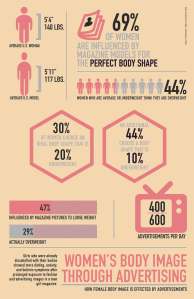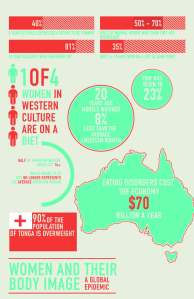Author Archives: bmkirts
Dove “Evolution” Video
Dove Evolution interview
History of how women are portrayed in advertising
Bethanie Kirts
Images of women have been used to sell products for decades. Beautiful women have appeared on countless products from creams to different food products and several other products. Advertisements of women have gone through several different transformations and imply a variety of different meanings, from Susie homemaker to the half naked women in countless magazines, and everything in between.
In advertising women take on many different roles and are molded into whatever the industry is trying to sell to the customer. They conform and become the tools for selling a variety of products for the company. For example, “wholesome and motherly images of women have been used to sell products like soaps, cleaning products, and housewares, because they evoke feelings of responsibility, the ideal homemaker and mother, and care for the family- all ideals women aspire to”. This type of image was especially predominant in the 1940s and 1950s due to the war and women having a more active say in what goes in the household.
Not only have women been portrayed as a homemaker, they have also been objectified as sex symbols and a symbol to desire. Unlike the different household products you use to find images of women on, now it is more likely to find these half naked extremely skinny women selling products such as clothing for women and products for men. These images would encourage women to buy these products in hopes of looking like the model in the advertisement, even though it was quite unrealistic.
As years pass by women are more and more objectified, especially in men’s magazines. Each company seems to be trying to push the bar just a little further and see how far they can go without going too far. For example, “an advertisement for men’s cologne may include idealized women flocking to a man wearing the product; this method of advertising speaks to the man’s desire to attract the ideal woman.
While images of women in advertising have changed, many portrayals still center on the idea of women as sex symbols. Several young women suffer from body image issues, because of the constant unrealistic images portrayed in the media. Women feel like there is a constant pressure of having to conform to these unrealistic and unhealthy images that appear in advertisements. The objectification of women may not only distort the image women have of their selves, but can also be linked to violence because women are portrayed as object. Women need to keep in mind that when viewing and advertisement the sole purpose is to sell a product. There are even images of naturally beautiful women that are still retouched and altered.
Women’s body image through advertising
 This info graphic focuses on the body images, shapes, and sizes that advertising and models portray to the public eye. It is unfortunate that most people know these body types are unhealthy and unrealistic, yet people still try to get to these sizes no matter the health risks.
This info graphic focuses on the body images, shapes, and sizes that advertising and models portray to the public eye. It is unfortunate that most people know these body types are unhealthy and unrealistic, yet people still try to get to these sizes no matter the health risks.

Look at the different “expectations” of what the woman’s body type should be in different parts of the world. Like anything else what is considered beautiful in one part of the world is different from another.
The western culture has an eating disorder epidemic and this graphic shows the amount of money spent and percent of women who try different dieting tactics.
Teen self esteem is extremely low, especially for young girls. Talking with parents is something teens wish would happen more often, boys want muscle, and girls want to be skinny
1. http://www.theguardian.com/fashion/2012/apr/28/abercrombie-fitch-savile-row
This article focuses on some of the differences customers feel, especially, towards Abercrombie & Fitch. The article states “For Beautiful People Only” that is sad that in our society there are brands such as this that discriminate against people that they do not find “beautiful”. The article not only talks about the stereotypical customers A&F has, but also touches on law suits from employees of different races that were made to do jobs that were more in the back of the store. A&F was also boycotted by many feminists groups due to the crude slogans, and inappropriate items for children.
2. http://www.beautyredefined.net/photoshopping-altering-images-and-our-minds/
There are rarely images of models, and celebrity women that have not been altered or enhanced in someway or another. This article focuses on the main ways photoshopping is done to almost every type of advertising. Photoshopping creates an unrealistic image of what a women’s body is supposed to look like to not only women, but young girls as well. The average women tries and tries to look like these photos, when in reality the women in the photo does not even look like that.
3. http://magazine.biola.edu/article/07-fall/why-do-we-struggle-with-beauty-and-body-image/
This article not only focuses on why women and young girls have negative body images, but also on ways they can get help. They mention ways to take healthy steps to recover from body issues, and ways your family can help. It also hits on other cultures and their perception of body types.
4. http://advertising.about.com/od/creatingads/a/Advertising-And-Women.htm
Advertising and women this is a huge aspect of our everyday society. Advertising and the media give a specific image and body type for what women are expected to look like. However this image in not realistic and something needs to be done to stop this objectification.
5. http://www.huffingtonpost.com/2014/01/17/aerie-unretouched-ads-photos_n_4618139.html
The article is something that all stores and advertising brands should focus on. The real beauty of girls, women, and models. All women are beautiful in their own way, and that should not be changed, enhanced, or airbrushed. Women are all unique with their eye color, hair color, skin color, tattoos, birth marks, freckles, shape of body, etc and that is all perfectly fine. Advertisements should not try to portray one specific body image or look because everyone is uniquely beautiful in their own way.
A Sad Stereotypical Society
My slide show focuses on what and how certain stores expect their main demographic to look and dress like. If the customer does not fit the expectation then they are out of luck if they are wanting to shop at this store. I wanted to focus on this because I think it is sad that in our society there are certain stores that only let a certain “stereotype” of people shop there, and do nothing to expand their demographics. To me anyone should be able to shop anywhere they want no matter their look or size, and stores should be able to meet the needs of all shapes and sizes.
Which is changing, the beauty or the beholder?
A quick overview of my cross platform project will be looking at the evolution of women’s body types, and what is considered beautiful to the public eye. The goal of my project is to educate the public on the changing perception of what is considered beautiful in relation to women and their physical appearance. In my blog I will focus on the different stereotypical “beautiful” body types for women and how those perceptions have drastically changed from generation to generation. The causes for these changes derive from what the media advertises to the public to be viewed as beautiful. What used to be popular, and publicly portrayed as being beautiful is nowhere near what is now being considered beautiful. In past generations, those thought to be beautiful were quite voluptuous, and very curvy, with a pale complexion. Now, after a few generations have passed, the media has taken it upon itself to change the definition of what is considered beautiful. Now they portray the “norm” to be a size 0, very tall, and as tan as possible. Those who are not up to those “standards” are just airbrushed and physically enhanced in other ways to conform to those standards. However, even some of the women who are very skinny and tan still get criticized by other demographics for being “too” skinny or “too” tan. I believe that women in today’s society are in a lose-lose situation. They are either considered too fat or too skinny, too pale or too tan, too tall or too short, the list is endless. “Television, magazines, movies, newspapers, billboards, and the internet are all powerful creators of the ‘desirable’ man or woman. They reinforce and perpetuate stereotypes with which we compare the reality of our own bodies. Similarities between the ‘ideal’ and our own bodies are commended and differences are considered unattractive”(Australian Sports Commission). Even girls are taught at a young age that the perception of beauty is unachievable. For example, consider “Barbie’s” long blond hair, her glassy eyed stare, perfect features, and 40-18-32 measurements. These perceptions of beauty are what is causing problems in society. No one can achieve the same features as Barbie, yet children are taught at a young age that Barbie is the standard for what is pretty. This causes girls to start using tanning beds, go on “diets” at a very young age, and use make-up in grade school. Does anyone else get sick watching the children’s beauty pageants on TV? Those girls are caked with make-up, spray tanned, wearing fake teeth, tons of jewelry, fake nails, and wearing provocative clothing. What happened to little kids being innocent and cute, wearing pig-tails, missing their front teeth, and wearing silly mismatched outfits? It’s sickening to see how some children are raised to conform to the new definition of beauty in our society, just because the media has began to portray it in such a way. Whether you are 5’11” or 4’11”, 115 lbs. or 215 lbs., tan or pale, you can still be beautiful, because true beauty is on the inside.

Reference List:
Australian Sports Commission. (2014, February 3). Retrieved from http://www.ausport.gov.au
Dreisbach, S. (2012). Glamour. Retrieved from http://www.glamour.com/health-fitness/2012/05/weight-stereotyping-the-secret-way-people-are-judging-you-based-on-your-body-glamour-june-2012
Young, A. (n.d.). The Negative Portrayal of Women. Retrieved from http://library.thinkquest.org/21298/Mind&Body/Portrayl.html

